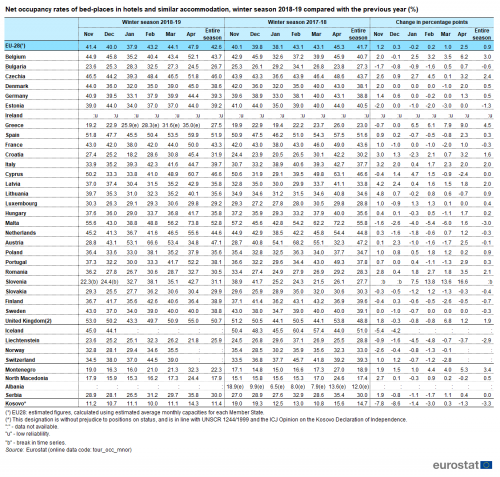Data from October 2019
Planned article update: No planned update
Highlights
Change in number of nights spent at hotels and similar accommodation, winter season 2018-19 compared with the same period in 2017-18 (%)
This article analyses the tourism trends of the 2018-2019 winter season[1] in the European Union (EU) Member States, EFTA and candidate countries. In terms of nights spent at hotels and similar accommodation establishments, tourism recorded positive growth rates in most countries compared with the same period in 2017-2018.
2018-2019 winter season: positive growth for tourism in EU-28
Comparing the monthly figures for the entire 2018-2019 winter season with the same period of the previous year, 18.9 million more nights (+2.6 %) were spent in hotels and similar establishments in the European Union. This positive growth was reflected in the national figures of 25 out of 27 Member States where data is available. The highest increase was observed in Romania (+8.6 %) followed by Croatia (+7.4 %) and Poland (+7.3 %), while declines were reported by Greece (-8.3 %) and Malta (-3.5 %) (See Figure 1 and Table 1).

Source: Eurostat (tour_occ_nim)
The most popular destinations for tourists travelling outside their own country of residence during the winter season 2018-2019 were Spain, the United Kingdom, Italy and Austria. The flows to these four countries accounted for more than half (55 %) of all nights spent by non-residents in the EU-28 hotels and similar establishments.
Residents and non-residents contributed equally to the increase of nights spent
At EU-28 level the number of nights spent by non-residents in hotels and similar accommodation establishments increased by 2.8 % in the winter season 2018-2019 compared with the same period of the previous year. The biggest increase was reported by the United Kingdom (+14.9 %) while in eight Member States the number of nights spent by foreign tourists decreased. The biggest drop (-10.3 %) was reported by Greece (see Table 1).

Source: Eurostat (tour_occ_nim)
The highest shares of non-residents were recorded in Malta, Cyprus and Luxembourg (93.4 %, 90.4 % and 88.5 % respectively), while they were particularly low in Sweden (22.6 %), Romania (22.8 %), Germany (24.0 %) and Poland (27.2 %) .
The number of nights spent by residents in hotels and similar accommodation increased by 2.4 % at EU-28 level, following the increase of domestic tourism in all Member States except Greece and the United Kingdom.
Malta had the highest occupancy rate of bed places ...
Compared with the same period of the previous year, net occupancy rates of bed places in the European Union increased by 0.9 percentage points during the 2018-2019 winter season. These rates ranged from 18.2 % in Croatia (January 2019) to 73.8 % in Malta (April 2019) (See Table 2).

Source: Eurostat (tour_occ_mnor), (tour_occ_nim)
In most of the countries, April was the month with the highest occupancy rates of bed places (See Figure 2). Malta was the country with the highest net occupancy rate in the peak month (73.8 %, April), followed by Austria (66.6 %, February), Cyprus (60.7 %, April) and Spain (59.9 %, April).

Source: Eurostat (tour_occ_mnor)
... and of bedrooms
During the winter season 2018-2019 net occupancy rates of bedrooms in hotels and similar accommodation establishments ranged from 20.2 % in Greece (November 2018) to 82.1 % in Malta (April 2019) (See Table 3).

Source: Eurostat (tour_occ_mnor), (tour_occ_nim)
In most of the countries, April was the month with the highest occupancy rates of bedrooms (See Figure 3). Malta was the country with the highest net occupancy rate in the peak month (82.1 %, April) followed by Austria (77.7 %, February), the Netherlands (76.3 %, April) and the United Kingdom (76.1 %, November).

Source: Eurostat (tour_occ_mnor)
Source data for tables and graphs
Data sources
Net occupancy rates of bedrooms: aggregates for EU-28 and estimates for periods longer than one month are not available for bedroom occupancy rates.
Context
The EU is a major tourist destination, with five Member States among the world’s top ten destinations for holidaymakers, according to UNWTO[2] data. Tourism is an important activity in the EU which has the potential to contribute towards employment and economic growth, as well as to development in rural, peripheral or less-developed areas. These characteristics drive the demand for reliable and harmonised statistics within this field, as well as within the wider context of regional policy and sustainable development policy areas.
- ↑ The winter season runs from November to April of the following year. For example, the 2018-2019 winter season ran from November 2018 to April 2019.
- ↑ UNWTO Tourism Highlights
Footnotes
Explore further
Other articles
Database
Thematic section
Publications
Selected datasets
- Tourism (t_tour)
Methodology
- Occupancy of tourist accommodation establishments (ESMS metadata file — tour_occ_esms)
- Tourism statistics in the European Statistical System - 2008 data
External links
- Agenda for a sustainable and competitive European tourism (Communication from the European Commission, October 2007)
- European Commission - Directorate-General for Internal Market, Industry, Entrepreneurship and SMEs - Tourism
Legislation
- With 2012 as reference year:
- Regulation (EU) No 692/2011 of 6 July 2011 concerning European statistics on tourism and repealing Council Directive 95/57/EC. (Summary)
- Regulation (EU) No 1051/2011 of 20 October 2011 implementing Regulation (EU) No 692/2011 concerning European statistics on tourism, as regards the structure of the quality reports and the transmission of the data.
- Previous legal acts (concerning reference periods before 2012):
- Commission Decision 1999/35/CE of 9 December 1998 on the procedures for implementing Council Directive 95/57/EC on the collection of statistical information in the field of tourism.
- Commission Decision 2004/883/CE of 10 December 2004 adjusting the Annex to Council Directive 95/57/EC on the collection of statistical information in the field of tourism as regards country lists.
- Directive 95/57/EC of 23 November 1995 on the collection of statistical information in the field of tourism.
- Directive 2006/110/EC of 20 November 2006 adapting Directives 95/57/EC and 2001/109/EC in the field of statistics, by reason of the accession of Bulgaria and Romania.
